Paediatric Cochlear Implants
South Wales Cochlear Implant Programme
Welcome to the South Wales Cochlear Implant Programme!
Here you will find a wealth of information about cochlear implants and the services we provide.
Please use the tabs below for further information
Contact Details
If you wish to contact the paediatric cochlear implant team, please use the following email address, which is monitored throughout working hours (Mon-Fri, 8:30-5:00).
Paedsci.Helpline.Cav@wales.nhs.uk
Alternatively, telephone numbers are:
Tracy Hughes (administrator): 02921 844563 (Tues-Thurs)
Children’s Team: 02921 845054 or text 07855 078 241
Children will also have a key worker assigned to them who will share their work mobile number with you.
Medical Emergency
If you have a medical emergency please contact your local A&E Department. If you have a medical concern during working hours please contact the Cochlear Implant Team on the contact details above, outside of normal working hours contact NHS Wales 111 Service for advice.
What to do when your child has ingested a button/coin cell:
- In the event of battery ingestion, seek immediate medical attention at your local Accident & Emergency Department.
- Do not let your child eat or drink until an X-ray can determine if a battery is present.
- If you still have the battery packaging or the device containing the battery take this with you to help the doctor identify the battery type and chemistry.
For further information about battery safety please click this link for an information sheet.
Batteries
Disposable batteries are available from us and can be requested using our email address or telephone numbers as listed above. However, we recommend the use of your rechargeable batteries when these are provided.
How we hear
In a normally-hearing ear, the outer part (the pinna) catches sound waves and directs them into the ear canal and towards the ear-drum. When the sound waves collide with the ear-drum they cause it to vibrate. The ear-drum is attached to three tiny bones in the middle ear called the malleus, incus and stapes (collectively known as the ossicles). These three bones strengthen the vibrations from the ear-drum and pass then on to the inner part of the ear, known as the cochlea.
The cochlea looks like a snail shell and is filled with fluid. It also contains thousands of microscopic sound-sensitive cells, called hair cells. The vibrations entering the cochlea from the middle ear ossicles cause the fluid inside the cochlea to move. This causes the hair cells to bend, similar to the movement of seaweed on the seabed when waves pass over them.
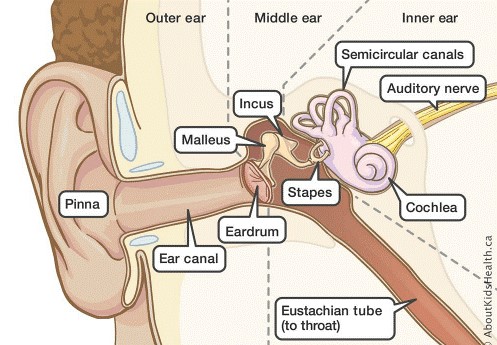
This movement or bending of the hair cells causes electrical nerve signals to be sent from the cochlea, along the auditory nerve, to the brain where they are recognised as sound.
Hearing Loss
Hearing loss (or deafness) occurs when one or more parts of the ear are not working properly. There are two main types of hearing loss – conductive hearing loss and sensorineural hearing loss.
- Conductive hearing loss
This happens when the sound waves are unable to pass efficiently from the outer ear (the pinna and ear canal) and middle ear (the ear-drum and ossicles). There are many things that can cause this to happen, such as…
Wax blocking the ear canal
Fluid in the middle ear (glue ear)
Perforated ear-drum
A conductive hearing loss can be either temporary or permanent, depending on the cause.
- Sensorineural Hearing Loss
This happens when the inner part of the ear (the cochlea) isn’t working effectively. This is usually because the microscopic hair cells are damaged or missing. Sensorineural hearing losses are usually permanent.
It is also possible to have a hearing loss which is a combination of a conductive and sensorineural hearing loss. This is known as a mixed hearing loss.
Hearing loss can be classified as mild, moderate, severe or profound, depending on what sounds a person is able to hear and the level at which these sounds are heard. The diagram below shows the categories of hearing loss on a hearing chart, called an audiogram.
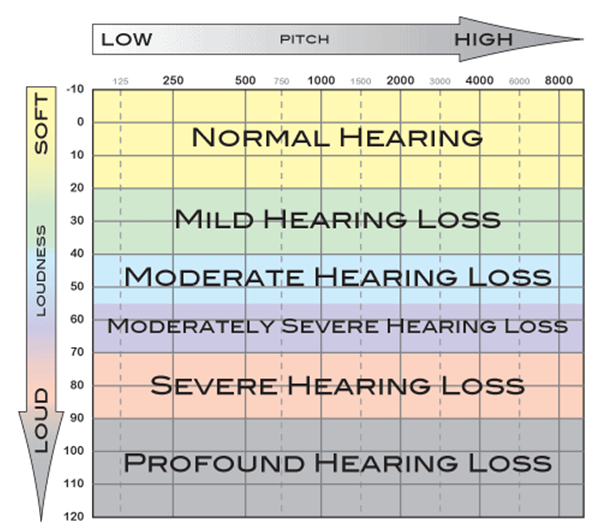
Conductive hearing losses usually cause a mild or moderate hearing loss. Sensorineural hearing losses usually cause permanent deafness which can be of any severity.
- How does Deafness affect young children?
When hearing babies are born, they immediately become aware of the environmental sounds around them. As they develop, they gradually learn to associate the sounds with the sound source. They watch facial expressions and listen to the sounds coming from the parent’s mouth. They begin to make sense of these and learn to understand speech and language before being able to use language to express themselves. Babbling begins as they experiment with the sounds heard and attempt to produce them. They then start to imitate some of the speech and very gradually develop spontaneous language.
When a child has a hearing loss, access to sound is affected which influences the development of listening and speaking skills. This can then affect the acquisition of literacy skills. The rehabilitation team will therefore work with your child and develop a structured teaching approach to help him/her develop communication skills. Sometimes this will be with the help of sign language or other visual information.
- What is a cochlear implant?
A cochlear implant is a small electronic device that can help to provide a sense of sound to a person who has a severe or profound hearing impairment. They may be suitable for children or adults who receive little benefit from conventional hearing aids.
All cochlear implants have external and internal parts.
The external part consists of a sound processor and transmitter coil. The sound processor is usually worn behind the ear and has a microphone to pick up the sounds. The transmitter coil passes sound information from the processor to the internal part. They are joined together by a small lead.
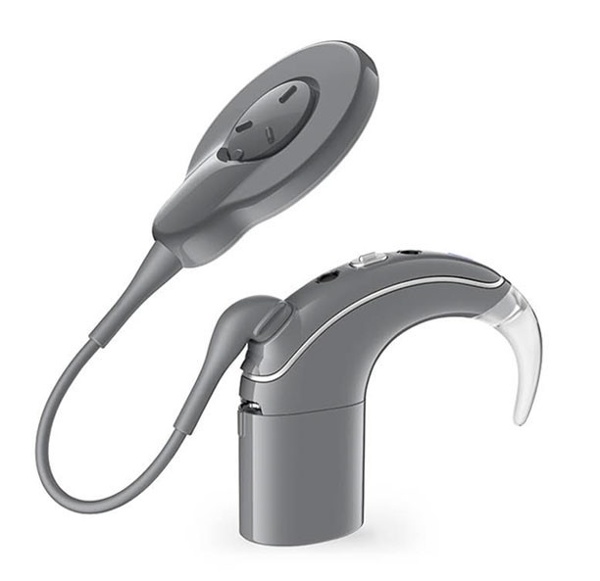
The internal part is implanted into the inner ear (cochlea) during surgery. It consists of a receiver which is placed under the skin just above and behind the ear, and an electrode array which goes inside the cochlea.
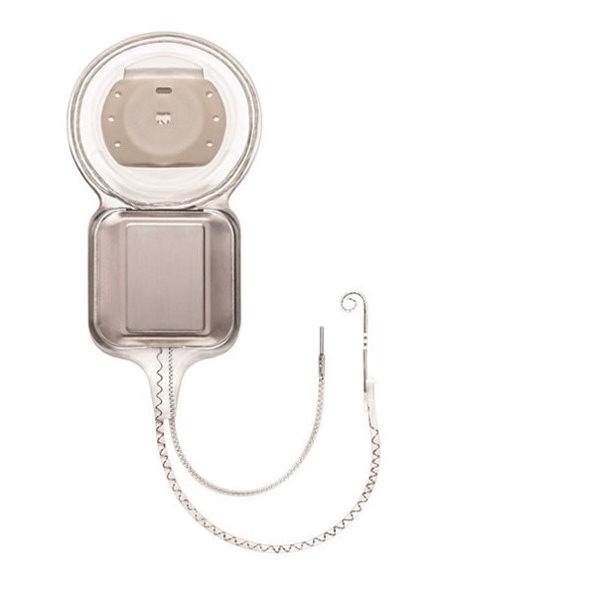
Both the receiver (internal part) and the transmitter coil (external part) contain magnets to allow the transmitter coil to stay in the correct position on the head.
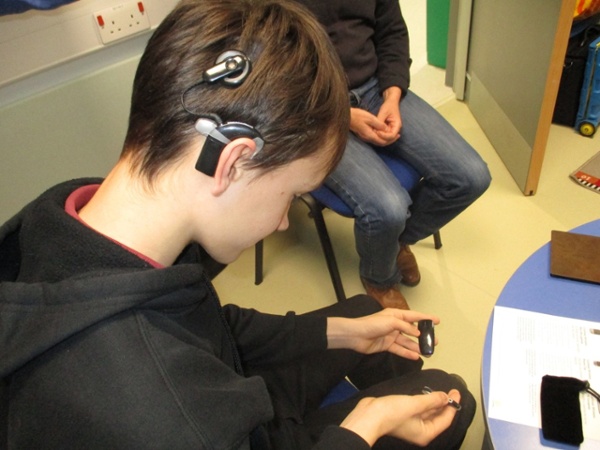
How does a cochlear implant work?
- Sounds are picked up by a microphone on the sound processor which is usually worn behind the ear. This changes the sound into electrical signals.
- The electrical signals are sent to the transmitter coil on the outside of the head. This converts the signal into radio waves and sends them to another coil (the receiver coil) just underneath the skin. Both the transmitter coil (external part) and receiver (internal part) contain magnets to allow the transmitter coil to stay in the correct position on the head.
- The receiver coil then sends electrical pulses down into to the cochlea, where they are received by different points of the implant called electrodes.
- The electrodes excite the nerve fibres in the cochlea, which then send the information along the auditory nerve to the brain which recognises the signals as sound.
A cochlear implant only helps a child to hear sounds when it is worn. It does not give normal hearing. When the processor is not worn, the child will not be able to hear anything.

How does a cochlear implant help?
A cochlear implant, unlike a hearing aid will by-pass the damaged sensory hair cells in the cochlea to activate the hearing nerve directly. Because of this people with profound hearing loss can experience hearing sensations that they cannot get from a hearing aid. The sounds are not exactly the same as natural hearing, but loud and clear enough for a child to learn to detect and identify environmental sounds and begin to understand speech with the help of lip reading. A child who receives an implant may not have had much experience of sound and will therefore need intensive rehabilitation to make sense of it.
Rehabilitation involves
- Learning what environmental sounds are, detecting them and eventually discriminating between them.
- Learning to detect loud and quiet sounds, short and long sounds, one or many sounds.
- Eventually listening to speech with lip-reading, learning which sounds come from different lip shapes, which words contain these different sounds, and also which have a different number of syllables etc.
A child gradually developing these skills will begin to experiment with the sounds heard and may begin babbling as a young baby does before recognisable words begin to emerge. This will take many years of individual rehabilitation and also natural integration into a hearing world of sounds and language. A profoundly deaf child with a cochlear implant has an increased chance of developing intelligible speech. However, please remember that all children are individuals and their progress cannot be compared with each other.
What help does a child with cochlear implants need in school?
A child needs ample opportunity to fully integrate into the natural life of the school in the same way as a hearing child, with exposure to rich spoken language taught through a lively curriculum. However, extra support may be needed to help identify sounds and put them in context, to explain new words and to support speech with sign until comprehension of spoken language increases.
A child will need opportunities to work on a one to one basis with visiting specialists from the Cochlear Implant Team and local Speech and Language Therapist and Teacher of the Deaf and to work in small groups with support.
A programme of listening skills for the child to work on with local staff may also be provided by the implant team who will demonstrate how to implement it.
Assessment Process
The assessment procedure by the Cochlear Implant Team can take between 3 and 9 months. This amount of time is necessary in order to determine if your child would in fact benefit from cochlear implants (CI). During this time everyone involved in making a decision about cochlear implants, i.e. family & professionals can gather all of the information needed.
|
Step 1: Referral to Children’s Cochlear Implant Co-ordinator |
|
Step 2: Home and school visits arranged |
|
Step 3: Further appointment with CI team |
|
Step 4: Meeting other families of implanted children |
|
Step 5: Joint decision made between family and professionals on whether to proceed with cochlear implants |
Step 6: MRI and CT scans
Step7: Initial appointment in the CI clinic
Referral
The initial referral is usually made by your child’s local audiologist, ENT consultant or other health professional. Before being referred to the Cochlear Implant Programme your child will have been diagnosed with a severe or profound hearing loss. On receiving a referral, the CI co-ordinator will organise an initial appointment for you and your child.
Initial Appointment
The purpose of this appointment is to provide an opportunity for you and your child to meet the CI team. During this visit, you will likely meet a CI surgeon, a specialist paediatrician, an audiologist, a speech & language therapist and a teacher of the Deaf.
It is an opportunity for you and your child to find out information about cochlear implants and the assessment process. You can ask as many questions as you like!
It is also an opportunity for us to gather as much information as possible from you, and our ENT Consultant Surgeon will consider your child’s medical history and cause of deafness and discuss these issues with you. They will also explain what is involved in the operation and the risks involved.
We may need to do some hearing tests to determine hearing thresholds (the quietest sounds that can be heard). The type of test used will depend on the age of the child, and will likely be similar to the tests that they are used to doing in their own audiology clinics. We may also do some hearing tests to determine how much benefit their current hearing aids are providing. This will indicate whether cochlear implants or hearing aids will provide the best sound for your child. Sometimes this takes several visits, and it may be necessary for new hearing aids to be fitted and tried for a set period of time. As parents you will be asked for feedback about your child’s response to sound with these aids.
Home and school visits
The team’s speech and language therapist and teacher of the Deaf will visit you at home and your child’s school on several occasions to look at :
- Communication - your child’s ability to communicate with others, or his/her potential ability to develop speech and language will be explored
- Educational Development – to identify any additional difficulties together with cognitive development, general learning style, concentration and attention skills.
- Educational Placement - to consider if your child’s communication and rehabilitation needs would be catered for and to ensure there will be a committed support structure for your child.
We will visit you at home to ensure that as a family you are aware of the limitations of a cochlear implant and have the appropriate expectations for the future. As your child spends most of his/her time with the family we need to be sure that you will be in a position to communicate effectively with him/her. You will need to understand the need for your child to wear the processor and that you will make maximum use of his/her listening ability in order to help develop speech and language. As a family you must be willing and able to attend programming and rehabilitation sessions in the hospital and be willing to receive regular visits at home or at school and put into practice the advice from the rehabilitationists and audiologists. It will also be another opportunity for you to ask questions.
Meeting other families of implanted children
Professionals can give you a lot of information, but there is nothing more beneficial than talking to other parents who have been through the whole cochlear implant procedure and meeting their implanted children. We always offer this opportunity during assessment.
Your child will always be profoundly deaf. We will only recommend cochlear implants if we feel that there is more benefit to be gained from an implant than from continuing to be a hearing aid wearer. If your child is suitable for an implant we will be fully committed to his/her future progress and working towards developing a close working relationship with you as a family and everyone involved with your child.
Cochlear Implant Surgery
The operation is carried out at either the University Hospital of Wales in Cardiff or Llandough, and is performed by a team lead by one of our experienced Consultant ENT Surgeons: Mr Roblin, Mr Willians or Mr Hall.
On the day of the operation, the surgeon will come to the ward and talk to you and your child and explain what will happen. Your child will then be taken to theatre and given general anaesthetic. The operation usually takes 2-3 hours, and you and your child will need to stay in hospital for one night.
During the operation, the implant is placed under the skin and the electrode inserted into the cochlea. This is repeated on the other side if having two implants. The skin is closed with stitches that fall out naturally and a bandage is wrapped around the head to protect the ears and the scars. The bandage will need to stay in place for 48 hours.
After the operation, your child is taken back to the ward. The next day, the doctor will come and examine the ears and arrange for an x-ray to check the position of the implant within the inner ears. After this you can go home. An appointment will be made for you to return to the hospital in one week to check the ears again.
It is normal for the scar to look a little red in the first few weeks but this will improve in time.

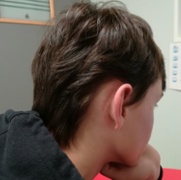
Pre-tuning visits at home
Your child will not hear anything until the processors are fitted, usually about 4 weeks after the operation. In the meantime, one of the rehabilitation team will arrange to come and visit you and your child at home to discuss what will happen next. Your child will be given the processors (although they will not work until they are switched on by the audiologist) so that you can get used to them and how they fit on the head and ears.
Switching-on the processors
About four weeks after the operation, the scars behind the ears should be healing nicely, and the processors can be switched on. An appointment will already have been made for your child to attend the audiology department at the Noah’s Ark Children’s Hospital for this to be done.
During the appointment, the audiologist will check the ears and scars and ensure that the processors are fitting well. Some checks will be carried out to find out what level the implants need to be for your child to start hearing with them. The processors will then be switched on at very quiet levels.
It is impossible to predict how a child will react when the processors are switched on for the first time. As the initial sound level is very low, the reaction can be very subtle such as stopping what they are doing, or just blinking. Sometimes children become upset, but it is important to remember that this is because they are not used to these new sensations in their ears, and not because it is causing them any discomfort.
The aim of the switch-on appointment is to provide your child with a low level of sound that they can gradually get used to at home until their next tuning appointment. They won’t hear very much, but will be able to start learning what sound is.
Over the next few days and weeks, try to gradually increase the amount of time the processors are worn. The more they wear the processors, the faster they will make progress. Some children may be happy to wear their processors all day, others may need more encouragement and coaxing. If they remove the processors and coils from their head, replace them (be patient - you may have to keep doing this!). It is important to be firm, consistent and persistent. It may feel very difficult at the time, but the rewards for your child once they have adjusted to the processor will be well worth it!
After the switch-on appointment, further tuning appointments will be arranged for:
- 1 week
- 1 month
- 3 months
- 6 months
After this, tuning appointments will usually be every six months for the first three years, and once a year thereafter. However, additional appointments can be arranged in between any of these if required.
During these initial tuning appointments, the maps (sound levels) will adjusted to make sure the sounds are comfortable and your child is hearing well. It will take weeks or months to learn to listen to and make sense of the sounds with the cochlear implants.
Rehabilitation Appointments
Rehabilitation is the process of maximising the new hearing that your child receives from the cochlear implants. It develops their understanding of sound in a happy, fun and relaxed way, and at the child’s own pace.
A program of home, school and/or clinic-based sessions will be planned and implemented by the rehabilitation team over the next few weeks. This will be with either a teacher of the deaf or speech and language therapist. These sessions will focus on listening skills, such as responding to and discriminating (telling the difference between) specific speech sounds, discriminating between words with different syllable numbers and recognising routine phrases. Speech and language may start to develop once all this is in place. After the first year, the frequency of rehabilitation sessions is gradually reduced, but we will always be on hand to provide support when required, through every stage of your child’s development.
About Us
The University Hospital of Wales Paediatric Cochlear Implant Programme began in 1995. It has gradually expanded and is now a well established, highly professional centre with a purpose built clinic in the Paediatric ENT/Audiology Outpatient Department in Noah’s Ark Children’s Hospital. The team have developed a wealth of experience implanting children of different ages and audiological backgrounds.
Aim of the Programme
- To provide a high quality, family focused cochlear implant programme at Cardiff and Vale University Health Board.
- To provide a programme with lifelong commitment to patients.
- To meet all of the British Cochlear Implant Group recommendations/Quality Standards.
The Paediatric Cochlear Implant Team
Cochlear implantation requires a wide variety of skills, therefore the team consists of a range of professionals who work closely together and with local professionals.
- Mr Gareth Williams Consultant ENT Surgeon
- Mr Graham Roblin Consultant ENT Surgeon
- Mr Andy Hall Consultant ENT Surgeon
- Hannah Morris Specialist Speech and Language Therapist & Programme Co-ordinator
- Sarah Angove Teacher of the Deaf
- Razun Miah Paediatric Lead Audiologist for Cochlear Implants
- Rhian Hughes Chief Audiologist
- Eirwen Jones Senior Audiologist
- Dr Zeba Khan Community Paediatrician
- Dr Nicole Pickerd Community Paediatrician
- Tracy Hughes Administrator
Faulty processor and replacement parts
Please make sure that any broken cables or coils are replaced from your child’s kit as/when required so that he/she is always able to use the device. If you have tried all of the spares and the processor still does not work, or if you do not have any of the replacement parts that you need, please refer to the contact details provided below, according to the relevant cochlear implant manufacturer.
Advanced Bionics
Please contact “AB4U” who will provide spares and repairs, and send them directly to you.
Phone: 01223 847 888
Text: 07827 324211
Email: customerservice.gb@AdvancedBionics.com
Address: 2 Breaks House,
Mill Court,
Great Shelford,
Cambridge,
CB22 5LD
Cochlear
Please contact “Cochlear Care” who will provide spares and repairs, and send them directly to you.
Freephone: 0800 035 6318
Direct Line: 01932 263 630
Mobile: 07767 167 824 (SMS only) Email: ukcare@cochlear.com
Address:
Cochlear Europe Ltd
6 Dashwood Lang Road
Bourne Business Park
Addlestone
Surrey
KT15 2HJ
MED-EL
Please contact “MED-EL Direct” who will provide spares and repairs, and send them directly to you.
Freephone : 0330 123 5601*
Mobile: 07930 363351 (SMS only) Email : direct@medel.co.uk
*Please check with your network provider as fees may apply
Useful Links
- The British Cochlear Implant Group (BCIG) is a professional body run by healthcare professionals and other interested parties, representing all the cochlear implant centres and other specialists involved in cochlear implantation in the UK.
- The National Deaf Children's Society (NDCS) offers information, family support, activities and events.
- The Royal National Institute for the Deaf (RNID) information on all aspects of hearing loss, including a wide range of leaflets and fact sheets.
- Cochlear Implanted Children's Support Group (CICS) - an independent, voluntary group run by parents whose children have cochlear implants to help others whose children already have implants and those who are considering cochlear implantation for their child whether unilateral, simultaneous or sequential bilateral. Provides support and the benefit of first-hand experience and offers practical help, ideas, advice and social gatherings.
- Teens information leaflet
- Listening through a CI (children’s guide)
- Battery safety information
- CI surgery check list
Manufacturer Specific websites and information leaflets
- Cochlear Website
- N7 quick user guide
- N7 Smart App pairing guide
- N7 Smart App User Guide
- Aqua case instructions
- Medel Website
- Sonnet 2 quick guide
- Advanced Bionics Website
Rydym yn croesawu galwadau ffôn yn Gymraeg, Saesneg a Iaith Arwyddion Prydain (BSL) via SignVideo.
We welcome phone calls in Welsh, English and British Sign Language (BSL) via SignVideo.